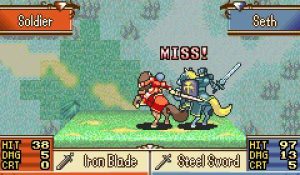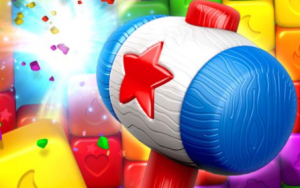Deconstructing C.A.T.S. Keeping Loyal Fans in PvP Games
Creating a novel mobile experience is a hard task. So when a novel mechanic appears it’s a breath of fresh air from the consistent Match-3 re-skins or Clash of Clones that more frequently release on a Thursday… The hardest part is making it stick. Getting people to come back and play everyday is the area that companies focus on during a soft launch. Those prototypes with the highest retention usually make it to market. Stickiness is slightly different from retention. It’s usually measured by DAU/MAU and I like to think of it as how many loyal fans are in your game. The more similar your DAU is to your MAU the stronger the loyalty.
Zeptolab’s C.A.T.S. – Crash Arena Turbo Stars is one game that has shown great potential to earn money and downloads, yet it’s slipped slightly down the charts. A recent update on June 7th has done a good job of stopping this slide where they corrected some of the basic frustrations but how to keep those loyal users playing each day is what we’ll investigate in this post.
C.A.T.S. – Gameplay
C.A.T.S. is a game which is unlike many others. In it you must build and battle incredible contraptions out of scraps and components that you find. There can be only one winner in the PvP battles and it’s a fight to the death, with the first player to 0 health loses. The rounds last between 2-15s, so feel lightning fast and the game encourages you to test and play with configurations. The rounds are completely pre-determined with no inputs needed from the player during an actual match. You sit back and watch your contraption fight in an entirely automatic way. Each part has a feel or structure that affects the way it will work. As a player, through trial and error, you learn what works best.

C.A.T.S Gameplay
The gameplay seems simple, but the skill is in countering or playing the scraps that you have that have the highest stats and therefore are more likely to beat your opponent. The games novelty hinges on an epic (24 league) but very succinct leaderboard system.
Stickiness is a measure of how many loyal fans there are in your game.
League System
You start your game within level 1 of 24 different leagues. Every 4-5 leagues are grouped by materials with wooden, through to metal all the way upto carbon parts. Each of these parts then has a maximum stat available measured by a standard 5* system. You want better materials with higher stars if you want the best stats. The league system provides an incredibly clear objective and a clear sense of progression. Each league is its own challenge, every time I beat a league I unlock better parts and I have a real sense of achievement. This solves a common issue of players not understanding what to do next? Here it’s laid out in a perfectly ordered and linear path towards the top players and leagues. Positive reinforcement leads to stronger uptake and a clear and tangible reward awaits you at the end of each league – a permanent unlock of better stared parts!
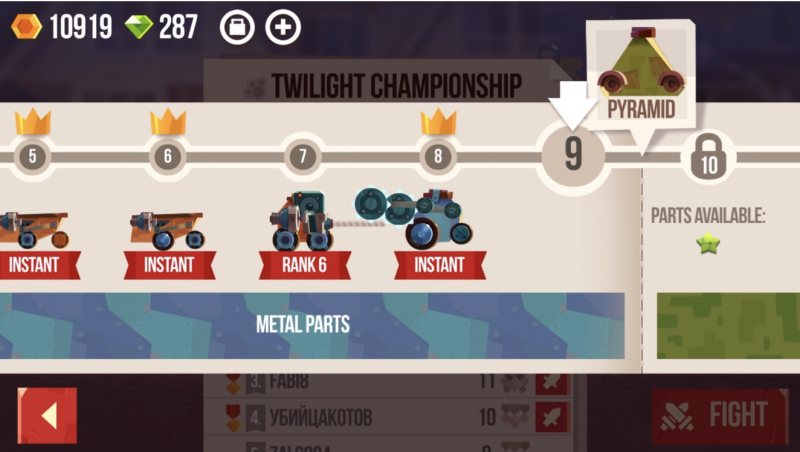
Leagues also do a great job of putting you in better match range with similar skilled and similar paying players. This is used to great effect in most competitive PvP games such as Clash of Clans, Chess or League of Legends on PC. ELO and it’s variants are used when a score based method matches people of similar scores. C.A.T.S does this in a different way, with a progressive win funnel. Progress in the game is reliant on you either winning 14 matches in a row, or being at the top of a division when that division ends every 24-48h. Once you progress you have made it to the next division and there is no way to drop back down, leagues are used more like a progression mechanic than a competitive mechanic.
The rewards for progression are clear, better stats for your gear and at certain points unlocks of better gear itself. Progressing from one league to another is the most rewarding point in the game and instantly as a player you’re drops are more likely to be better.
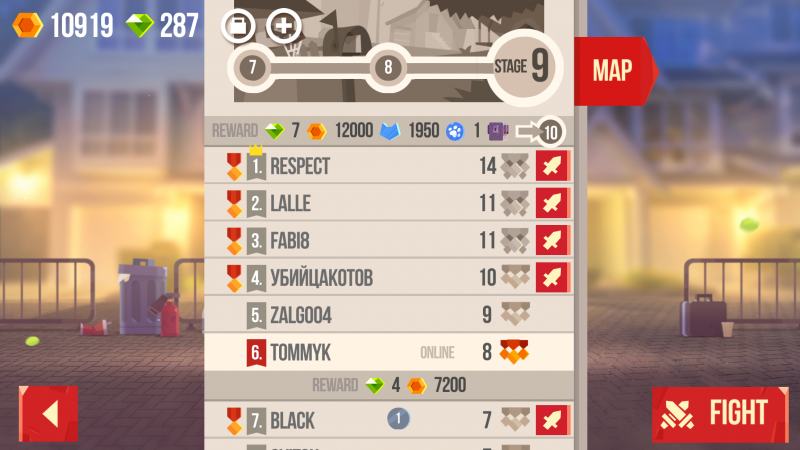
League progression is also tied directly into a timer of around 36h. When the timer hits 0, whoever is top of the league will progress. This is a great retention mechanic that is further leveraged by a push notification 1h before the league finishes, encouraging you to log back in and play. Creating a repeating timetable with an incentive to compete day to day is one of the best drivers of mid-term retention. I remember that Wooga’s Diamond Dash had a weekly competition that worked well on Facebook but on mobile they saw a number of players only logging in once a week to submit a single high score, win the league and get the rewards. Shorter league cycles work well on mobile, but only when their is still enough progression between leagues to provide enough runway for your top spenders to keep wanting to spend to progress.
Parts System (Stats + Luck)
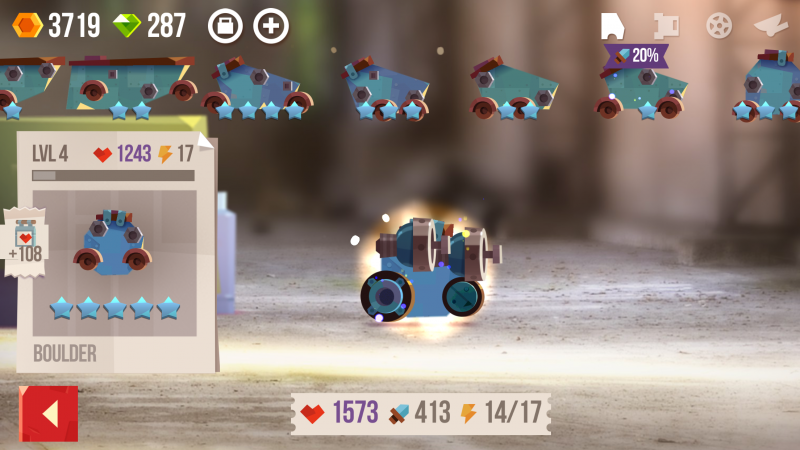
There are at least 30 different parts in the game. All parts drop via crates that drop when you win matches. The rarity of the part and the exact placement of certain attachment or wheel placement points are randomly dropped. Having a rare part with a large amount of energy and lots of slots is the luckiest thing that you could have.
Each part’s stats can be improved by fusing older parts into the part itself to level it up. Therefore each part has a Start Stat and a Max Stat. The Max Stat is slightly arbitrary as parts seem to be able to fuse an infinite number of time, but they get proportionally more and more expensive to do so. This creates a theoretical efficient maximum of around a level 10 fusion levels per star. The game balances the Start Stat of the next league part level with roughly a level 6-8 part, meaning as a player you always want a higher star part as it will eventually give you much better stats as you level it up. The graphs use interpreted numbers and are just used to visually demonstrate the curve, they are not the numbers from the real game.
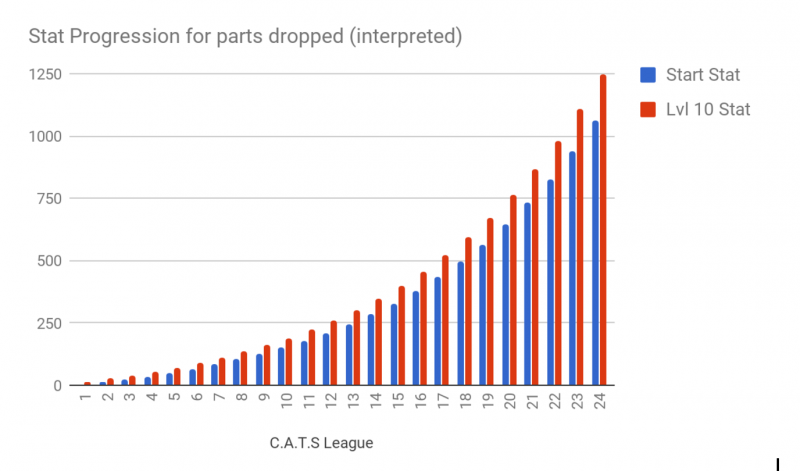
Notice how the jump between the lvl 10 stat and the next part is alway just slightly under the previous level. Every high level part is valuable.
As you play the leagues you notice the contraption parts begin to change colour and texture. Texture changes with each new material and colour changes every 1*,3* and 5*. This visual clarity immediately helps you to understand why certain contraptions beat you. You get a great visual representation of the power of each element and you know by looking when it’s time to change your parts.
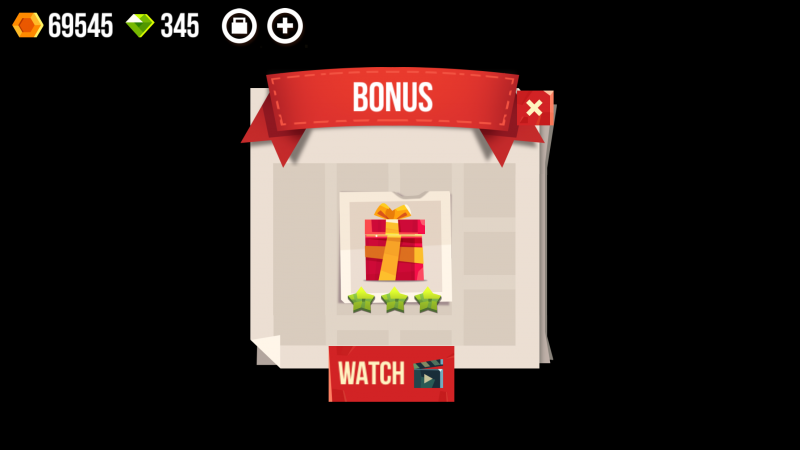
A really nice feature added in the most recent update is to allow people watch a video ad in order to earn a guaranteed max star part for the current league you are in. This is a great use of the Unique Ability mobile video monetisation method I described in the Futureplay video ads article. It allows Zeptolab to generate revenue from a feature that has almost 0 direct cost to the balance or progression systems within the game itself.
Fusion (More Stats)
Fusing parts is a common mechanic in RPG games, the Gem system in diablo II comes to mind. It gives every drop, no matter it’s rarity or stats a value within the game and as you build up any one item some of the value is maintained and can be consolidated into your next item. This form of system works very well as every drop of parts, no matter the star level, has value.
Fusion systems work on exponentially increasing costs matched with linear gains to the stats of the item itself. Usually the growth curves might have varying values depending on which aspects of the game the balancer wants to make feel valuable/punishing.
If there was only a fusion system, you would always want to combine every old part into the highest stared new part. However, there are also certain characteristics that do not change or grow in stats, Energy Cost, Direction/Configuration, Part Bonus. These 3 items change the way the part physically works in game. Certain builds work better with certain parts. To clearly identify very valuable parts, they established Legendary parts that always give 100% bonus if used on the correct vehicle.
Unlike classic RPG games where players usually combine or combo certain parts so that they have positive reinforcements during gameplay, C.A.T.S. has very limited interaction between parts. For instance you don’t have a damage over time element that could be combined with a slow. Fusion really becomes a method to clean your inventory rather than an interesting or unlocking mechanic. If parts grew and changed their functionality, Rocket launchers might speed up their fire rate or spinning saws grow larger, then fusion would have a further purpose than simply growing the stats.
Every drop of parts, no matter the star level, has value.
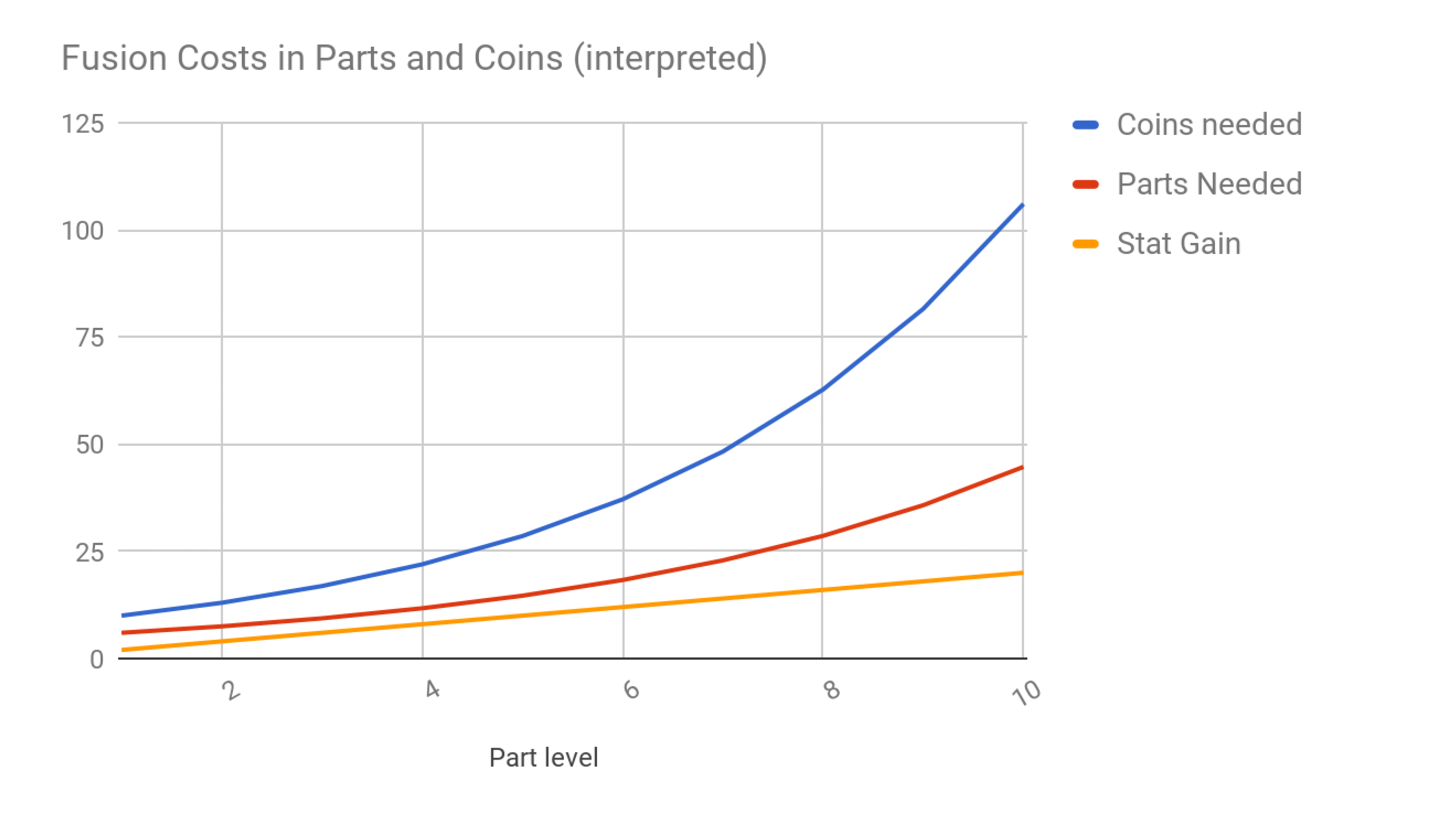
Fusing parts becomes stat inefficient the more times you do it.
Configuration (Skill)
The only aspect of the game that requires skill, is placing which parts where and choosing which base to use with any particular machine. At first this is interesting, you are quickly unlocking parts and discovering new items that work well together, but this quickly dries up as most drops become duplicates. I found that unlike other games whereby a metagame is created around countering other players configurations by using a configuration that punishes it, C.A.T.S. lacked this meta. The configuration and skill required was greatly outweighed by the larger stats, winning. Therefore the game never became about building a configuration that beat your opponents, but building a configuration that produced the best stats.
Certain configurations compliment each other, for instance the boulder which is a short but stocky base works better with spinning discs, or the titan which is a large but high HP tower works well with ranged weapons. So choosing compliments helped. However, never was this more obvious when I landed two weapons that both boosted my titans attack points. The boost was so large that it was a more effective contraption if I left the wheels off and thus increased the distance my opponent had to travel before reaching me. This let me get 2 clear shots off with 2x rockets leading me to level up 4 ranks in quick succession. Although this is a form of Configuration, the skill involved was nowhere near as beneficial to me as my boosted weaponry.
Stickiness: the balance of Stats, Skill, and Luck
The game features all 3 elements that help to make a great game fun. However, the ratios and balance feels weighted too heavily towards stats. At the start of the game, 7-14 days this miss balanced system isn’t apparent as you are upgrading at a great rate and earning more and more interesting parts. However, hitting the mid-game is where you start to notice the reliance on high stat parts. The main progression loop feels like:
- Players get a drop of a powerful part (good configuration, high star value)
- Players use this to combo and get a very high value machine that win’s tournaments
- Players progress 1,2 or 3 leagues quickly.
- Players now face much harder higher part levels and their old configuration is useless.
- Players must now wait or pay with the hope of getting a new powerful part.
- Their old powerful machine is redundant and must be merged into new parts.
Powerful strategies become completely redundant through stat progression, not skill progression. During the early game this progress loop continues to happen fast and redundancy isn’t as noticeable as your parts quickly get upgraded 3 or 4 levels. However, when particular high value parts or combo parts are needed, the loop grinds to a halt.
Powerful strategies become completely redundant through stat progression, not skill progression.
If you compare this to Clash Royale’s card system, rather than your old cards becoming redundant, the metagame (the discussion of the game outside of the game) progresses each week with cards that combo well together to counter popular decks. No card ever becomes redundant, cards shift in popularity. The stats of cards become less and less important as you progress as it takes such a long amount of time to collect enough material to fuse and power-up your card, that skill and deckbuilding become the primary factor that determines which league you are in. This creates a much more loyal and engaged fanbase. So much so that the metagame has moved to other channels such as YouTube or Twitch. People are now more focussed on learning what decks to build than which stats are needed to beat other players.
This is noticeable to players, and affects their loyalty. PvP games need to always strike a balance between allowing spenders to pay to win, but no allowing spenders to dominate because they paid. C.A.T.S. biggest issue is that no matter what my skill level I always do better with better stats cards. Therefore the veil of fun is pulled clearly off revealing the power that a purchase of new cards will provide, better stats. Your players notice this and can’t engage, encourage or create a meaningful metagame around your game. If the only skill is in configuration and everyone has different drops, what is there to really talk about, buy more crates to win?
Conclusion
C.A.T.S. looks to be ZeptoLab’s next big hit on the AppStore. They’ve shown they can innovate and create novel game experiences, and this is translating into big growth on the AppStore. It shot directly into the top 10 downloads and it’s top grossing is still in the top 100 three weeks after release. The unique gameplay, great visuals and smooth interactions are a pleasure to play.
But whether the game will stick on the grossing charts will be based on it’s balance between stats, skill and luck. Currently C.A.T.S. has favoured stats too strongly for it’s win condition. The other two elements become mere footnotes in the shadow of a 100% bonus or a 1,000 damage rocket launcher. As games are only 20 seconds long, you’re exposed very quickly to what beats what. Once the novelty, beauty and intrigue has been exposed and the progression of ever increasing numbers becomes your only focus, the game loses some of it’s fun factor.
The success of any online PvP game is driven by it’s metagame (The C.A.T.S. reddit). For metagames to work they need to be constantly evolving, skill led and fair. Fans become loyal if each of these factors is present. C.A.T.S. needs to encourage more discussion around the skill of contraptions. They need to consolidate pieces so that players retain their redundant parts for future build configurations and they need to ensure that stat progression is kept within limits so that the game feels fair for both payers and players.
I still see a bright future ahead for C.A.T.S. as there is no other game like it and it’s great fun building cool fighting machines. Giving their fans more to talk about and obsess over will help to build out a loyal community that can actively engage for years. If Zeptolab can get that right i’m sure we’ll see C.A.T.S storming the chart yet again!




